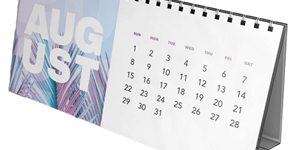The design of a desk calendar isn’t just about aesthetics; it also has a significant impact on your psychology and productivity. In this blog post, we will explore the psychology behind desk calendar design, focusing on how colors and layouts can influence your work habits.
- Color Psychology: Different colors evoke different emotions and moods. For example, blue is often associated with calm and focus, making it suitable for a desk calendar in a workspace. Red can signify urgency or importance, while green can represent growth and balance. Consider the psychological impact of color when choosing your calendar.
- Layout and Organization: The layout of your desk calendar can affect your productivity. A cluttered or disorganized layout can lead to feelings of overwhelm and stress. In contrast, a clean, well-structured layout with ample space for notes can encourage organization and efficient planning.
- Visual Hierarchy: An effective desk calendar should have a clear visual hierarchy. Important dates or tasks should stand out, and less critical information should be less prominent. This helps you prioritize and focus on what matters most.
- Motivational Elements: Incorporating motivational quotes or images in your desk calendar design can boost your mood and motivation. It can serve as a daily source of inspiration, driving you to accomplish your goals.
- Customization: The ability to personalize your desk calendar allows you to tailor it to your specific needs and preferences. This customization can enhance your sense of ownership and connection to the calendar, making you more likely to use it consistently.
In summary, the design of your desk calendar goes beyond aesthetics; it can impact your psychological state and productivity. When choosing a desk calendar, consider the psychological effects of colors, layout, and customization options to create a tool that enhances your work habits and mindset.













